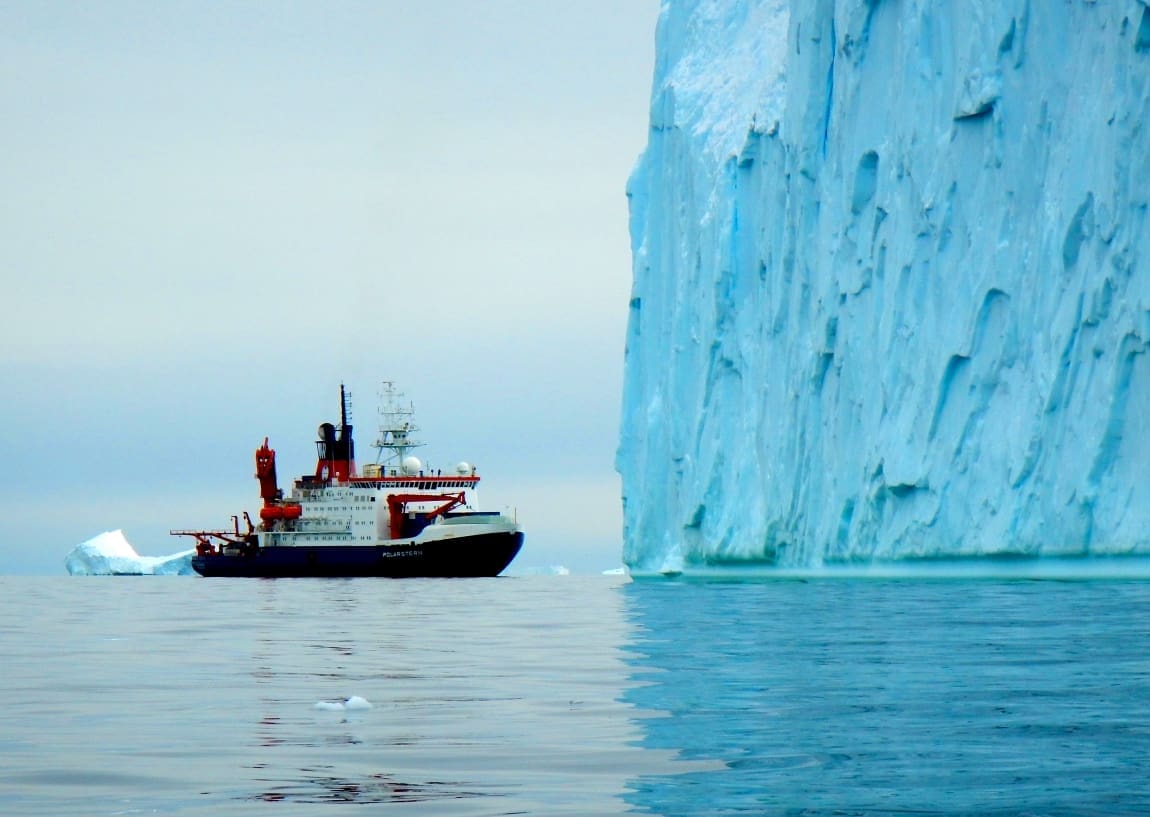For the first time, the recovery of unique geological samples combined with sophisticated modelling provides surprising insights into when and where today’s Antarctic ice sheet formed.
By Alfred Wegener Institute (AWI), Helmholtz Centre for Polar and Marine Research
In recent years global warming has left its mark on the Antarctic ice sheets. The “eternal” ice in Antarctica is melting faster than previously assumed, particularly in West Antarctica more than East Antarctica. The root for this could lie in its formation, as an international research team led by the Alfred Wegener Institute has now discovered: sediment samples from drill cores combined with complex climate and ice-sheet modelling show that permanent glaciation of Antarctica began around 34 million years ago – but did not encompass the entire continent as previously assumed, but rather was confined to the eastern region of the continent (East Antarctica). It was not until at least 7 million years later that ice was able to advance towards West Antarctic coasts.
The results of the new study show how substantially differently East and West Antarctica react to external forcing, as the researchers describe in the prestigious journal Science.
Around 34 million years ago, our planet underwent one of the most fundamental climate shifts that still influences global climate conditions today: the transition from a greenhouse world, with no or very little accumulation of continental ice, to an icehouse world, with large permanently glaciated areas.
During this time, the Antarctic ice sheet built up. How, when and, above all, where, was not yet known due to a lack of reliable data and samples from key regions, especially from West Antarctica, that document the changes in the past.
Researchers from the Alfred Wegener Institute, Helmholtz Centre for Polar and Marine Research (AWI) have now been able to close this knowledge gap, together with colleagues from the British Antarctic Survey, Heidelberg University, Northumbria University (UK), and the MARUM – Center for Marine Environmental Sciences at the University of Bremen, in addition to collaborators from the Universities in Aachen, Leipzig, Hamburg, Bremen, and Kiel, as well as the University of Tasmania (Australia), Imperial College London (UK), Université de Fribourg (Switzerland), Universidad de Granada (Spain), Leicester University (UK), Texas A&M University (USA), Senckenberg am Meer, and the Federal Institute for Geosciences and Natural Resources in Hanover, Germany.

Based on a drill core that the researchers retrieved using the MARUM-MeBo70 seafloor drill rig in a location offshore the Pine Island and Thwaites glaciers on the Amundsen Sea coast of West Antarctica, they were able to establish the history of the dawn of the icy Antarctic continent for the first time.
Surprisingly, no signs of the presence of ice can be found in this region during the first major phase of Antarctic glaciation. “This means that a large-scale, permanent first glaciation must have begun somewhere in East Antarctica,” says Dr Johann Klages, geologist at the AWI who led the research team. This is because West Antarctica remained ice-free during this first glacial maximum. At this time, it was still largely covered by dense broadleaf forests and a cool-temperate climate that prevented ice from forming in West Antarctica.
East and West Antarctica react very different to external conditions
In order to better understand where the first permanent ice formed in Antarctica, the AWI paleoclimate modelers combined the newly available data together with existing data on air and water temperatures and the occurrence of ice.
“The simulation has supported the results of the geologists’ unique core,” says Prof Dr Gerrit Lohmann, paleoclimate modeler at the AWI. “This completely changes what we know about the first Antarctic glaciation.”
According to the study, the basic climatic conditions for the formation of permanent ice only prevailed in the coastal regions of the East Antarctic Northern Victoria Land. Here, moist air masses reached the strongly rising Transantarctic Mountains – ideal conditions for permanent snow and subsequent formation of ice caps. From there, the ice sheet spread rapidly into the East Antarctic hinterland.
However, it took some time before it reached West Antarctica: “It wasn’t until about seven million years later that conditions allowed for advance of an ice sheet to the West Antarctic coast,” explains Hanna Knahl, a paleoclimate modeler at the AWI. “Our results clearly show how cold it had to get before the ice could advance to cover West Antarctica that, at that time, was already below sea level in many parts.”
What the investigations also impressively show is how different the two regions of the Antarctic ice sheet react to external influences and fundamental climatic changes. “Even a slight warming is enough to cause the ice in West Antarctica to melt again – and that’s exactly where we are right now,” adds Johann Klages.
The findings of the international research team are critical for understanding the extreme climate transition from the greenhouse climate to our current icehouse climate.
Importantly, the study also provides new insight that allows climate models to simulate more accurately how permanently glaciated areas affect global climate dynamics, that is the interactions between ice, ocean and atmosphere. This is of crucial importance, as Johann Klages says: “Especially in light of the fact that we could be facing such a fundamental climate change again in the near future.”

Using new technology to gain unique insights
The researchers were able to close this knowledge gap with the help of a unique drill core that they retrieved during the expedition PS104 on the research vessel Polarstern in West Antarctica in 2017. The MARUM-MeBo70 drill rig developed at MARUM in Bremen was used for the first time in Antarctica. The seabed off the West Antarctic Pine Island and Thwaites glaciers is so hard that it was previously impossible to reach deep sediments using conventional drilling methods.
The MARUM-MeBo70 has a rotating cutterhead, which made it possible to drill about 10 meters into the seabed and retrieve the samples.
The research project, and the Polarstern expedition PS104 in particular, was funded by the AWI, MARUM, the British Antarctic Survey, and the NERC UK-IODP Programme.
More information: J. P. Klages, C.-D. Hillenbrand, S. M. Bohaty, U. Salzmann, T. Bickert, G. Lohmann, H. S. Knahl, P. Gierz, L. Niu, J. Titschack, G. Kuhn, T. Frederichs, J. Müller, T. Bauersachs, R. D. Larter, K. Hochmuth, W. Ehrmann, G. Nehrke, F. J. Rodríguez-Tovar, G. Schmiedl, S. Spezzaferri, A. Läufer, F. Lisker, T. van de Flierdt, A. Eisenhauer, G. Uenzelmann-Neben, O. Esper, J. A. Smith, H. Pälike, C. Spiegel, R. Dziadek, T. A. Ronge, T. Freudenthal, and K. Gohl, ‘Ice sheet-free West Antarctica during peak early Oligocene glaciation’, Science (0, eadj3931; 2024). DOI: 10.1126/science.adj3931. AWI Press Release. Featured image: FS Polarstern in the inner Pine Island Bay Credit: Alfred-Wegener-Institut / Johann




